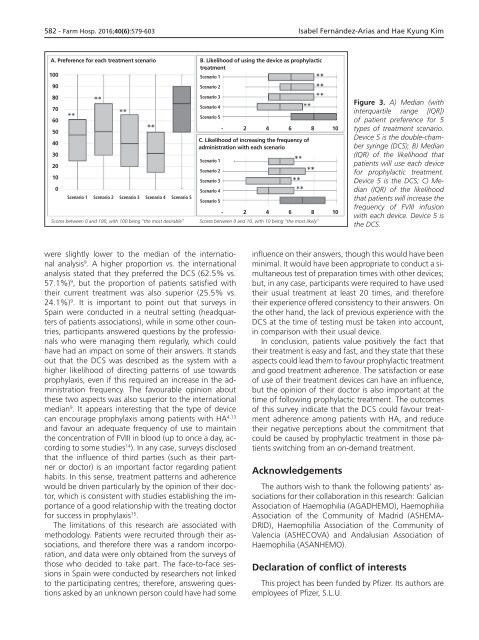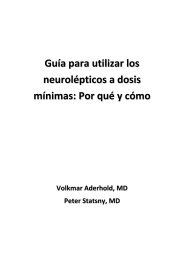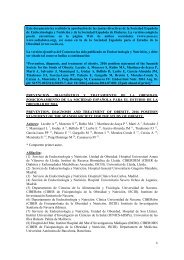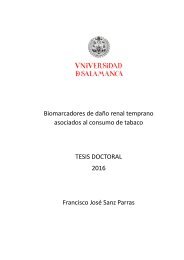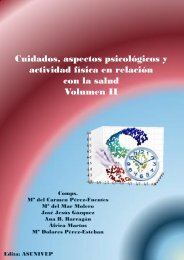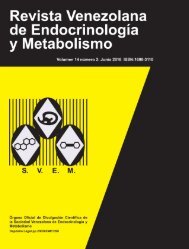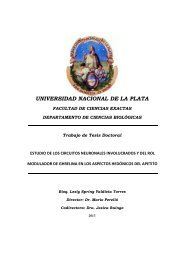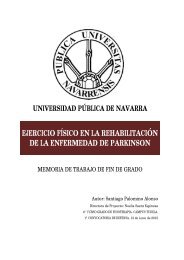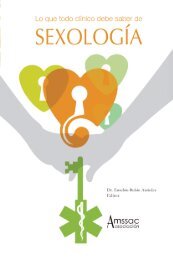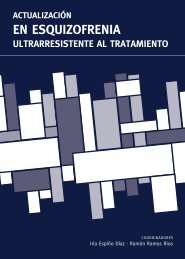Noviembre-Diciembre
156_v40n6(1)
156_v40n6(1)
Create successful ePaper yourself
Turn your PDF publications into a flip-book with our unique Google optimized e-Paper software.
582 - Farm Hosp. 2016;40(6):579-603 Isabel Fernández-Arias and Hae Kyung Kim<br />
A. Preference for each treatment scenario B. Likelihood of using the device as prophylactic<br />
treatment<br />
100<br />
90<br />
80<br />
70<br />
60<br />
Scenario 1<br />
Scenario 2<br />
Scenario 3<br />
Scenario 4<br />
Scenario 5<br />
50<br />
- 2 4 6 8 10<br />
40<br />
C. Likelihood of increasing the frequency of<br />
administration with each scenario<br />
30<br />
Scenario 1<br />
20<br />
Scenario 2<br />
10<br />
0<br />
Scenario 3<br />
Scenario 4<br />
Scenario 1 Scenario 2 Scenario 3 Scenario 4 Scenario 5<br />
Scenario 5<br />
- 2 4 6 8 10<br />
Scores between 0 and 100, with 100 being “the most desirable” Scores between 0 and 10, with 10 being “the most likely”<br />
Figure 3. A) Median (with<br />
interquartile range [IQR])<br />
of patient preference for 5<br />
types of treatment scenario.<br />
Device 5 is the double-chamber<br />
syringe (DCS); B) Median<br />
(IQR) of the likelihood that<br />
patients will use each device<br />
for prophylactic treatment.<br />
Device 5 is the DCS; C) Median<br />
(IQR) of the likelihood<br />
that patients will increase the<br />
frequency of FVIII infusion<br />
with each device. Device 5 is<br />
the DCS.<br />
were slightly lower to the median of the international<br />
analysis 9 . A higher proportion vs. the international<br />
analysis stated that they preferred the DCS (62.5% vs.<br />
57.1%) 9 , but the proportion of patients satisfied with<br />
their current treatment was also superior (25.5% vs.<br />
24.1%) 9 . It is important to point out that surveys in<br />
Spain were conducted in a neutral setting (headquarters<br />
of patients associations), while in some other countries,<br />
participants answered questions by the professionals<br />
who were managing them regularly, which could<br />
have had an impact on some of their answers. It stands<br />
out that the DCS was described as the system with a<br />
higher likelihood of directing patterns of use towards<br />
prophylaxis, even if this required an increase in the administration<br />
frequency. The favourable opinion about<br />
these two aspects was also superior to the international<br />
median 9 . It appears interesting that the type of device<br />
can encourage prophylaxis among patients with HA 4,13<br />
and favour an adequate frequency of use to maintain<br />
the concentration of FVIII in blood (up to once a day, according<br />
to some studies 14 ). In any case, surveys disclosed<br />
that the influence of third parties (such as their partner<br />
or doctor) is an important factor regarding patient<br />
habits. In this sense, treatment patterns and adherence<br />
would be driven particularly by the opinion of their doctor,<br />
which is consistent with studies establishing the importance<br />
of a good relationship with the treating doctor<br />
for success in prophylaxis 15 .<br />
The limitations of this research are associated with<br />
methodology. Patients were recruited through their associations,<br />
and therefore there was a random incorporation,<br />
and data were only obtained from the surveys of<br />
those who decided to take part. The face-to-face sessions<br />
in Spain were conducted by researchers not linked<br />
to the participating centres; therefore, answering questions<br />
asked by an unknown person could have had some<br />
influence on their answers, though this would have been<br />
minimal. It would have been appropriate to conduct a simultaneous<br />
test of preparation times with other devices;<br />
but, in any case, participants were required to have used<br />
their usual treatment at least 20 times, and therefore<br />
their experience offered consistency to their answers. On<br />
the other hand, the lack of previous experience with the<br />
DCS at the time of testing must be taken into account,<br />
in comparison with their usual device.<br />
In conclusion, patients value positively the fact that<br />
their treatment is easy and fast, and they state that these<br />
aspects could lead them to favour prophylactic treatment<br />
and good treatment adherence. The satisfaction or ease<br />
of use of their treatment devices can have an influence,<br />
but the opinion of their doctor is also important at the<br />
time of following prophylactic treatment. The outcomes<br />
of this survey indicate that the DCS could favour treatment<br />
adherence among patients with HA, and reduce<br />
their negative perceptions about the commitment that<br />
could be caused by prophylactic treatment in those patients<br />
switching from an on-demand treatment.<br />
Acknowledgements<br />
The authors wish to thank the following patients’ associations<br />
for their collaboration in this research: Galician<br />
Association of Haemophilia (AGADHEMO), Haemophilia<br />
Association of the Community of Madrid (ASHEMA-<br />
DRID), Haemophilia Association of the Community of<br />
Valencia (ASHECOVA) and Andalusian Association of<br />
Haemophilia (ASANHEMO).<br />
Declaration of conflict of interests<br />
This project has been funded by Pfizer. Its authors are<br />
employees of Pfizer, S.L.U.


